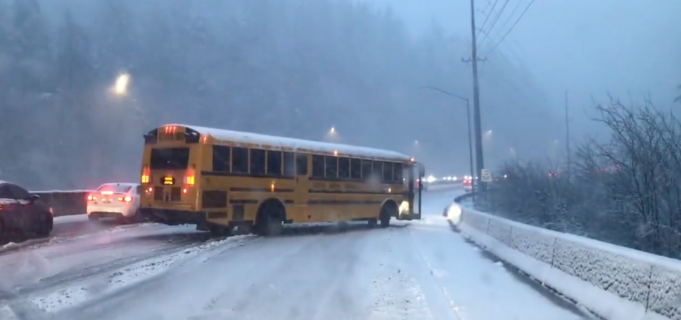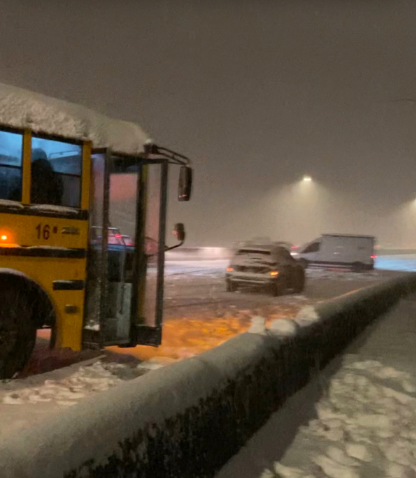The inside scoop on the snow day bus debacle
By Olivia Morrison ‘24
CGS bus blocking lanes on the freeway, image courtesy of The Weather Channel
On February 22nd, Portland was caught up in a surprise snowstorm that covered the city in up to 10 inches of snow, effectively shutting the city down for several days. According to the National Weather Service, the storm was historic, being the second-largest snow total ever recorded for Portland. Snowy and icy conditions caused school closures, flight cancellations, road closures, and dangerous driving conditions.
Roads became very slick and icy, causing major backups all over the city, especially on Interstate 5 near downtown and its junctions with Interstate 205 and 84. Hundreds of drivers were stuck in stagnant traffic for hours on end, not knowing when the traffic could be expected to clear up.
Snow had been continuously falling throughout the day on campus at Catlin Gabel (CGS), although it was not sticking until later in the day. Around 1:30 PM, CGS issued a message to the students and parents stating that all after-school activities would be canceled to allow students to get home.
However, bus routes still weren’t changed, and when the buses departed, the snow was beginning to stick. One of the school buses was on the Blue route, delivering students to stops in Northeast Portland, where it had been snowing heavily all day.
Attempting to get students home from school around 3:30, the bus hit a huge backup, and after traveling around 5 miles in 90 minutes, the bus slipped on the icy road into the barricade on the side of U.S. 26 (Sunset highway) near the Jefferson Street exit.
“The bus started sliding and we were like ‘that doesn’t seem right,’” commented Sofia Rutman, a junior who was riding the bus at the time.
At that point, the bus’s progress, as well as that of the cars surrounding it, came to a complete standstill.
“We basically stayed next to the Oregon Zoo for the whole time and we did not move at all,” comments August Walrod, a freshman on the bus.
Once it became apparent that the bus was not going to be moving, the six-hour wait ensued. Rutman explained that there was a range of emotions that students were feeling during this time, with some younger students feeling like the whole experience was “an adventure” while others were pretty distressed.
“Most of the high schoolers I think were just pretty resigned,” Rutman says.
“It was mostly just boring,” comments Isaac Robinette, a sophomore who, unfortunately, also forgot his phone on the day of the incident.
But, as Rutman stated, even as many students came to accept their situation, many also wondered what the plan of action was. But it became apparent as the night went on, that there was not much of a plan.
First, the bus aimed to get to the first stop on the route and drop everyone off there, then they planned to drop everyone off at Lincoln high school, then finally the plan was just to wait for the Oregon Department of Transportation (ODOT) to bring chains to the bus or pick up the stranded students.
Robinette explains that he didn’t know what CGS was doing at the time to help the situation, “it was all on ODOT and the parents to come to get us,” he explained.
Walrod agrees that “there could have been a lot more communication” from CGS, and that “[t]here was kind of a sense that no one was actually coming to help us” which greatly contributed to the stress and confusion of the moment.
One idea that was popular among the students was to leave the bus and walk off the exit.
“We all wanted to walk, pretty much we all understood that the bus wasn’t going to move,” says Rutman.
The CGS school bus on the freeway courtesy of Sofia Rutman
But alas, the students were not able to walk off of the bus because the roads were very dangerous. With cars sliding into one another and the freeway barrier, the adults didn’t want to put anyone in danger or take on that liability.
Other than the bus driver, who was busy on the phone communicating with ODOT, another woman entered the bus to help keep people calm.
“The bus driver seemed very thankful,” says Walrod. But, he adds, “[s]he was definitely a character.”
The only thing that the students knew about the woman was a second-grade teacher from a Beaverton school, and she stayed with the students on the bus for around 4 hours. Robinette, Walrod, and Rutman all agreed in saying that she helped keep the younger students calm, however, for the high school students, her presence was more confusing.
“I feel like she was better for the younger kids, she didn’t really know how to interact with high schoolers as well, because she would just tell us things like ‘the bus is moving’ and it just wasn’t,” Rutman stated.
As time went on, Walrod also explained that “[f]ood, water, having to go to the bathroom, and battery all became an issue, so that definitely contributed to the paranoia.”
People began to fill their water bottles with snow as well as share snacks and battery power with one another. They were also allowed to go off the bus for one bathroom break.
Students on the bus also needed to come up with different ways to fight off the boredom, which became increasingly difficult throughout the 6 hours. People entertained themselves by throwing snowballs inside the bus, doing their homework as well as helping younger students with their work, and simply looking out the window at the scene surrounding them.
“We could look at what was happening outside the window, there were a ton of news reporters, and people just came up,” Walrod described. “You could see crazy things, like crashes happening before your eyes, and people on bicycles, people going on runs, a lot of crazy weird stuff that normally wouldn’t happen.”
Finally, around 9:45 pm, a group of parents came to rescue the students and bring them back to a nearby house that was more easily accessible to parents. They walked off the freeway down the Jefferson Street exit, at last away from the bus.
Students walking off the freeway courtesy of Sofia Rutman
Once they got to the CGS student’s house, people had the choice to get picked up by their parents or stay the night if they needed to. Robinette was able to successfully take TriMet home, while Rutman and Walrod were able to be picked up by parents. All three made it home around 11:00 at night.
Rutman explained that the 40-minute car ride back to her home was nothing compared to the six-hour wait on the bus, and it was frustrating to think about what would have happened if they had been allowed to leave the bus earlier.
Walrod, who was later interviewed by the Oregonian for an article and reached out to by the New York Times, concluded: “I think it’s a really hard situation to deal with, but I think we could have been more prepared.”



